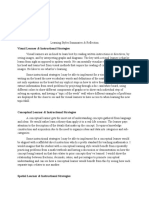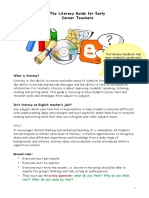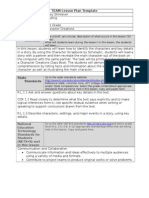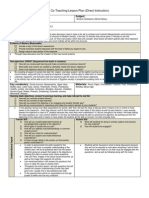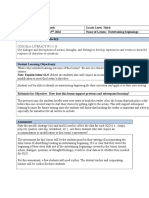Weebly
Weebly
Uploaded by
api-242143006Copyright:
Available Formats
Weebly
Weebly
Uploaded by
api-242143006Original Title
Copyright
Available Formats
Share this document
Did you find this document useful?
Is this content inappropriate?
Copyright:
Available Formats
Weebly
Weebly
Uploaded by
api-242143006Copyright:
Available Formats
Table 2.2.2 Unit Design Narrative (limited to 2 pages) Why are the objectives appropriate?
The objectives are relevant to the topic of rhythmic notation. They are also appropriate because the students in this grade level are ready to learn how to accurately read and notate rhythms. They are sequenced in the order in a scaffolding manner. Each lesson is supposed to build off of one another. Students learn note values and actions to help them remember. Then they learn how to add them together corresponding to time signature. Then, students can compose rhythmic passages in simple meter. I also chose to sequence lessons this way so that students would continue to review the previous lesson, to help with repetition. I wanted to create lessons that would keep the students engaged. This is a class that learns better doing something rather than being talked to. They seem to respond best to visuals. I wanted to include as many visual examples I could. With a handful of lower level learners I also chose activities that would include lots of repetition to help students absorb the concepts easier. Since my lessons were developed from my learning objectives, they address the learning objectives directly. Students will begin the unit at the bottom level of Blooms taxonomy by being able to verbally identify note names and their values (Knowledge). Then students will be able to use physical actions to apply the values of notes. (Comprehension & Application). Students will learn simple meter and use basic math skills to use their knowledge, and comprehension to apply their previous knowledge to the new concept. Students will then apply their knowledge and compose (Synthesis) rhythmic notations and perform them for the class. The students will be doing a vocabulary activity to help with the identification process of notes and their values. They are also working on persuasive words. This will help them understand how to use persuasive vocabulary. Students will also be doing a syllable activity that will help
Why are the lessons sequenced in this manner?
Why were these instructional strategies/activities selected?
How do the instructional strategies/activities address the learning objectives for this unit? How will a variety of levels of thinking skills be addressed (e.g., Blooms Taxonomy)? Give specific examples of use.
Explain the reading strategies that will be used throughout the unit. Give specific examples. (Remember that using text is not a reading strategy)
them pull apart words. This will help them to pull apart words to help them understand them, like prefixes and suffixes. What resources will be needed for this unit (include school and community resources)? I will need use of the internet, SMART Board, computer, projector, and white board from the school. I am bringing in recyclable materials from a local coffee shop who agreed to donate items. These will be helpful to give examples to the students of what they should bring and offer an option for students who forget to bring an instrument. I will be using the internet to show the STOMP video. I will also be using the SMART Board for teacher instruction and student practice on the composition concept. This will be used as an informal formative assessment. The students will be using the note values and the knowledge of time signature to answer simple math problems. This also introduces solving simple algebraic equations. Students will also practice vocabulary and persuasive writing. This unit includes lots of teacher centered instruction where I will be teaching a concept and letting the students practice the concept. But, the group project allows student centered instruction where they are working together in groups and helping one another.
How will technology be integrated within the unit? Explain both teacher use and student use.
How does the unit demonstrate integration of content across and within content fields?
How does the unit demonstrate both teacher-centered and studentcentered instructional strategies?
You might also like
- Digital Product Lesson PlanDocument6 pagesDigital Product Lesson Planapi-317619349No ratings yet
- Robertson Planning CommentaryDocument21 pagesRobertson Planning CommentarybrrobertNo ratings yet
- Math ToolsDocument5 pagesMath Toolscedes414No ratings yet
- Math Reflective Lesson (Wright)Document3 pagesMath Reflective Lesson (Wright)TiaraMilesNo ratings yet
- Reflective Lesson Plan Model Rubric - 450 - Revised 2013Document7 pagesReflective Lesson Plan Model Rubric - 450 - Revised 2013dburns1No ratings yet
- Diversity LessonDocument5 pagesDiversity Lessonapi-254206113No ratings yet
- MST Observation 2Document6 pagesMST Observation 2api-329738348No ratings yet
- Missouri Pre-Service Teacher Assessment (Mopta) Lesson Plan Format/RubricDocument4 pagesMissouri Pre-Service Teacher Assessment (Mopta) Lesson Plan Format/Rubricapi-254119820No ratings yet
- Adding Lesson PlanDocument4 pagesAdding Lesson Planapi-527752646No ratings yet
- Reflective Lesson Plan 6Document7 pagesReflective Lesson Plan 6api-252760395No ratings yet
- Veronica Longoria Lessonplan Ae RevisedDocument2 pagesVeronica Longoria Lessonplan Ae Revisedapi-242753124No ratings yet
- Learning Styles Reflection and SummariesDocument3 pagesLearning Styles Reflection and Summariesapi-652792108No ratings yet
- Reflective LP Math 2Document8 pagesReflective LP Math 2api-315391021No ratings yet
- Lesson Plan & Implementation: Reflection and Analysis: College of EducationDocument3 pagesLesson Plan & Implementation: Reflection and Analysis: College of Educationapi-309758533No ratings yet
- Literacy HandbookDocument16 pagesLiteracy Handbookapi-299191866No ratings yet
- Shoemaker Andrea Week3Document4 pagesShoemaker Andrea Week3api-324805521No ratings yet
- Edma3200 Lesson5practicumDocument3 pagesEdma3200 Lesson5practicumapi-252533855No ratings yet
- Internship q3 Lesson Plan TemplateDocument3 pagesInternship q3 Lesson Plan Templateapi-646164307No ratings yet
- Converting Fraction RLPDocument7 pagesConverting Fraction RLPapi-241521494No ratings yet
- Lessonplan JamienicholsonDocument5 pagesLessonplan Jamienicholsonapi-211737810No ratings yet
- Briley Shinlever Lessonplan Educ216Document5 pagesBriley Shinlever Lessonplan Educ216api-287789432No ratings yet
- Maths SymmetryDocument4 pagesMaths Symmetryapi-360396514No ratings yet
- Unit 7 BlogDocument4 pagesUnit 7 Blogapi-736053488No ratings yet
- Task 3Document15 pagesTask 3api-295505041No ratings yet
- Edit 3218 Revised Ae Lesson PlanDocument5 pagesEdit 3218 Revised Ae Lesson Planapi-242668731No ratings yet
- Lesson Plan 4Document3 pagesLesson Plan 4api-283599791No ratings yet
- 4 ThgrademodelinglessonDocument4 pages4 Thgrademodelinglessonapi-548191768No ratings yet
- Edu 536 - Mini Lesson 7Document3 pagesEdu 536 - Mini Lesson 7api-251922415No ratings yet
- Lesson Plan AdjectivesDocument4 pagesLesson Plan Adjectivesapi-302003110No ratings yet
- Area and PerimeterDocument15 pagesArea and PerimeterShafika AidaNo ratings yet
- Identity Unit Lesson 1Document4 pagesIdentity Unit Lesson 1api-299373704No ratings yet
- Reading Code: History of MeasurementDocument4 pagesReading Code: History of MeasurementLizFiedlerNo ratings yet
- Inquiry (5E) Lesson Plan Template: For TeachersDocument5 pagesInquiry (5E) Lesson Plan Template: For Teachersapi-487905844No ratings yet
- Lesson Plan With AnnotationDocument8 pagesLesson Plan With Annotationapi-286447265No ratings yet
- IIED: ICT in Education Lesson Plan Form: Name of The LessonDocument4 pagesIIED: ICT in Education Lesson Plan Form: Name of The LessonTeachers Without Borders100% (1)
- Direct World History LPDocument3 pagesDirect World History LPapi-265066614No ratings yet
- BBPT Lesson Idea ItecpdfDocument2 pagesBBPT Lesson Idea Itecpdfapi-478270054No ratings yet
- Planning CommentaryDocument7 pagesPlanning Commentarydarnelllogan8No ratings yet
- Unit 5 Lesson 7 Math 5th GradeDocument3 pagesUnit 5 Lesson 7 Math 5th Gradeapi-448690566No ratings yet
- Effective Schools Observation Grade 8 - Mackenzie SmithDocument4 pagesEffective Schools Observation Grade 8 - Mackenzie Smithapi-493639741No ratings yet
- SPR 2014 Problem-Based Lesson Plan FormatDocument3 pagesSPR 2014 Problem-Based Lesson Plan Formatapi-269936092No ratings yet
- Task 3Document3 pagesTask 3api-350317110No ratings yet
- Discussions To Reply ToDocument4 pagesDiscussions To Reply Toandrew irunguNo ratings yet
- 442 lp2Document9 pages442 lp2api-222110053No ratings yet
- Technology Lesson Plan 2Document9 pagesTechnology Lesson Plan 2api-346286339No ratings yet
- Literacy HandbookDocument16 pagesLiteracy Handbookapi-299191866No ratings yet
- Lesson 5 - Entertaining BeginningsDocument4 pagesLesson 5 - Entertaining BeginningsAnonymous Z9zcD6BzNo ratings yet
- C Example 2Document15 pagesC Example 2freyawyy1999No ratings yet
- KnowledgeDocument3 pagesKnowledgeapi-341108813No ratings yet
- Observation 4 Lesson PlanDocument6 pagesObservation 4 Lesson Planapi-702381076No ratings yet
- Basic Productivity Tools LessonDocument2 pagesBasic Productivity Tools Lessonapi-680461516No ratings yet
- ReflectionDocument17 pagesReflectionngothikimchau.baNo ratings yet
- Planning CommentaryDocument8 pagesPlanning CommentaryShealagh Lyons100% (1)
- VV Lesson Ellen WeberDocument5 pagesVV Lesson Ellen Weberapi-331809608No ratings yet
- Write Words or Concepts Associated With The Essential Elements When Planning A LessonDocument4 pagesWrite Words or Concepts Associated With The Essential Elements When Planning A LessonEver Shekhaina-XavierNo ratings yet
- Unit 1: What Do You Like? Aims and ApproachesDocument9 pagesUnit 1: What Do You Like? Aims and ApproachesAlif SyahmiNo ratings yet
- 1-Scoe Lesson Planning Template Fa23 2 1Document5 pages1-Scoe Lesson Planning Template Fa23 2 1api-583052012No ratings yet
- Direct Instruction Lesson Plan Template: Everyday LivesDocument6 pagesDirect Instruction Lesson Plan Template: Everyday Livesapi-380696050No ratings yet
- Classroom-Ready Number Talks for Sixth, Seventh, and Eighth Grade Teachers: 1,000 Interactive Math Activities That Promote Conceptual Understanding and Computational FluencyFrom EverandClassroom-Ready Number Talks for Sixth, Seventh, and Eighth Grade Teachers: 1,000 Interactive Math Activities That Promote Conceptual Understanding and Computational FluencyNo ratings yet
- WeeblyDocument1 pageWeeblyapi-242143006No ratings yet
- Buster KPTPDocument39 pagesBuster KPTPapi-242143006No ratings yet
- WeeblyDocument1 pageWeeblyapi-242143006No ratings yet
- WeeblyDocument7 pagesWeeblyapi-242143006No ratings yet
- WeeblyDocument8 pagesWeeblyapi-242143006No ratings yet
- Mathematics Anxiety's Impact On Grade 11 General Mathematics PerformanceDocument6 pagesMathematics Anxiety's Impact On Grade 11 General Mathematics PerformanceJournal of Interdisciplinary PerspectivesNo ratings yet
- Lesson Plan On Science Process Skill: ObservationDocument3 pagesLesson Plan On Science Process Skill: ObservationCharlene C. GuiralNo ratings yet
- English Without Answers PDFDocument72 pagesEnglish Without Answers PDFgbalrajNo ratings yet
- ThinkingDocument32 pagesThinkingMalaika Noor 1277-FSS/BSPSY/F19No ratings yet
- PHD Thesis in Mass Communication and JournalismDocument6 pagesPHD Thesis in Mass Communication and Journalismkristiandersoncolumbia100% (2)
- Advanced Infantry Training Battalion School of Infantry - East Scout Sniper Course Prep-GuideDocument2 pagesAdvanced Infantry Training Battalion School of Infantry - East Scout Sniper Course Prep-GuideAlek PhabiovskyNo ratings yet
- National Learning Camp Pre-AssessmentDocument2 pagesNational Learning Camp Pre-Assessmentmay christy cabahit56% (9)
- Chap23 RRL DraftDocument29 pagesChap23 RRL DraftRosario AceraNo ratings yet
- Teacing Math M1L5Document6 pagesTeacing Math M1L5Jack Ciriaco RosalNo ratings yet
- Curriculum Mapping Template and SampleDocument3 pagesCurriculum Mapping Template and SamplejjmalazarteNo ratings yet
- Isabela College of Arts & Technology, Inc.: Tagaran, Cauayan City, IsabelaDocument65 pagesIsabela College of Arts & Technology, Inc.: Tagaran, Cauayan City, IsabelaAdriane PacuanNo ratings yet
- Human Resource Management Quiz Three Subject Code: Mgmt-608 Batch One 9 September 2014Document5 pagesHuman Resource Management Quiz Three Subject Code: Mgmt-608 Batch One 9 September 2014bijuajitheshNo ratings yet
- Sekolah Alam Bengawan Solo Dengan Pendekatan Ekologi Arsitektur Di Kabupaten KlatenDocument9 pagesSekolah Alam Bengawan Solo Dengan Pendekatan Ekologi Arsitektur Di Kabupaten KlatenNurul Fadilah HarahapNo ratings yet
- !module 6 Workbook - Delay GratificationDocument7 pages!module 6 Workbook - Delay GratificationIva Ukić50% (2)
- Role of Technology in Education: Dr. Meenakshi SharmaDocument8 pagesRole of Technology in Education: Dr. Meenakshi Sharmakate frances labradorNo ratings yet
- Aditya Academy Syllabus-II 2020Document7 pagesAditya Academy Syllabus-II 2020Tarun MajumdarNo ratings yet
- SF9 - 2019-2020 HummsDocument88 pagesSF9 - 2019-2020 HummsPeHmyang Pineda DielNo ratings yet
- Las English 4 - Write A Reaction About The Story ReadDocument6 pagesLas English 4 - Write A Reaction About The Story ReadPia MendozaNo ratings yet
- Ket 4 - Test 4Document9 pagesKet 4 - Test 4Thànhh LongNo ratings yet
- Covumaiphuongplus3 Deso01Document11 pagesCovumaiphuongplus3 Deso01luuluyen.nt81No ratings yet
- The Great Gatsby Social Class ThesisDocument8 pagesThe Great Gatsby Social Class Thesisafcndgbpy100% (2)
- Ageing Book 2015 DownloadDocument248 pagesAgeing Book 2015 DownloadДинг ДонгNo ratings yet
- AJKDocument93 pagesAJKFaisal HanifNo ratings yet
- Eventguide PDFDocument68 pagesEventguide PDFTytNo ratings yet
- The Colonial Mentality ScaleDocument12 pagesThe Colonial Mentality Scalenicoleta5aldeaNo ratings yet
- JHS Answer Sheet With RRS 1Document4 pagesJHS Answer Sheet With RRS 1Jovie Rommel LogronioNo ratings yet
- Learning TransferDocument19 pagesLearning TransferThu Hien PHAMNo ratings yet
- Tef Canada Study PlanDocument3 pagesTef Canada Study PlanDéépák Déépü100% (3)
- 2021 10 27 PM Tasks Client Mangement - SJKDocument43 pages2021 10 27 PM Tasks Client Mangement - SJKs kyleNo ratings yet
- Math 6-Q1-Week-4Document14 pagesMath 6-Q1-Week-4Angelo Freidrich O AmbalongNo ratings yet











